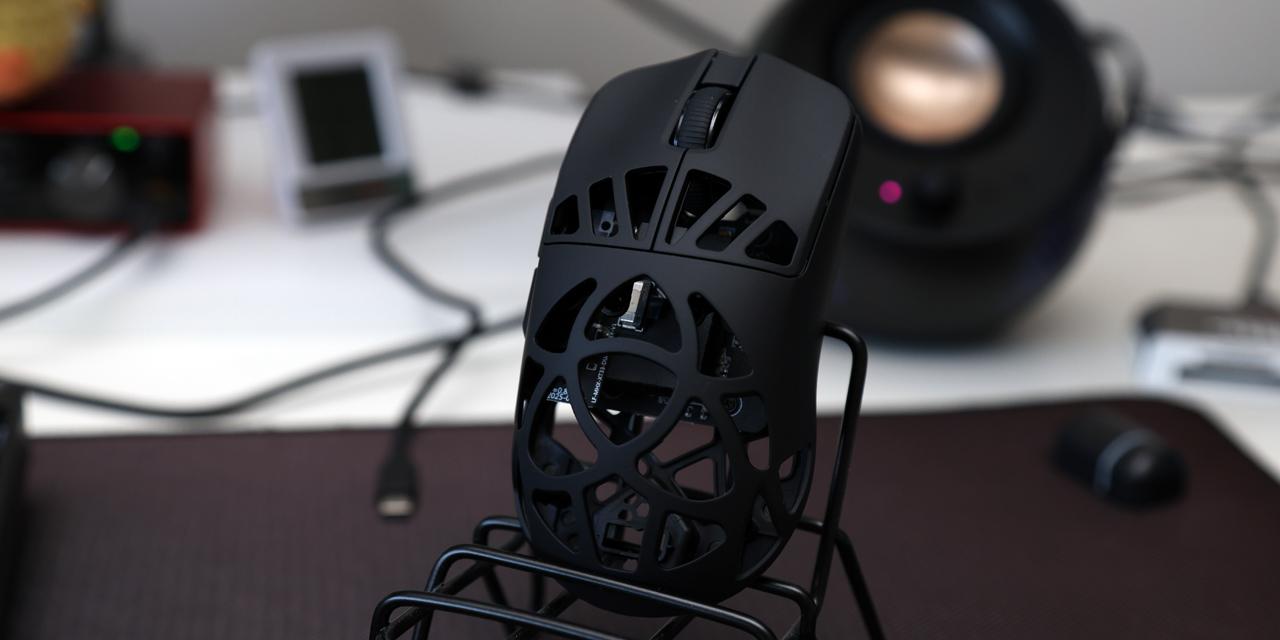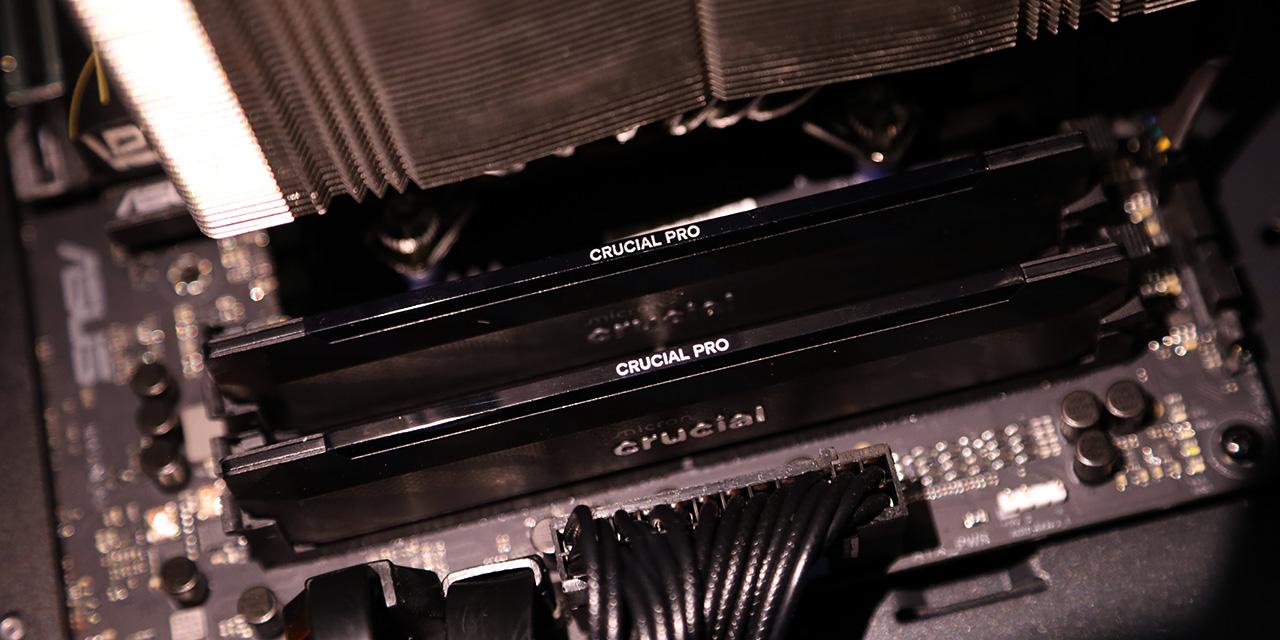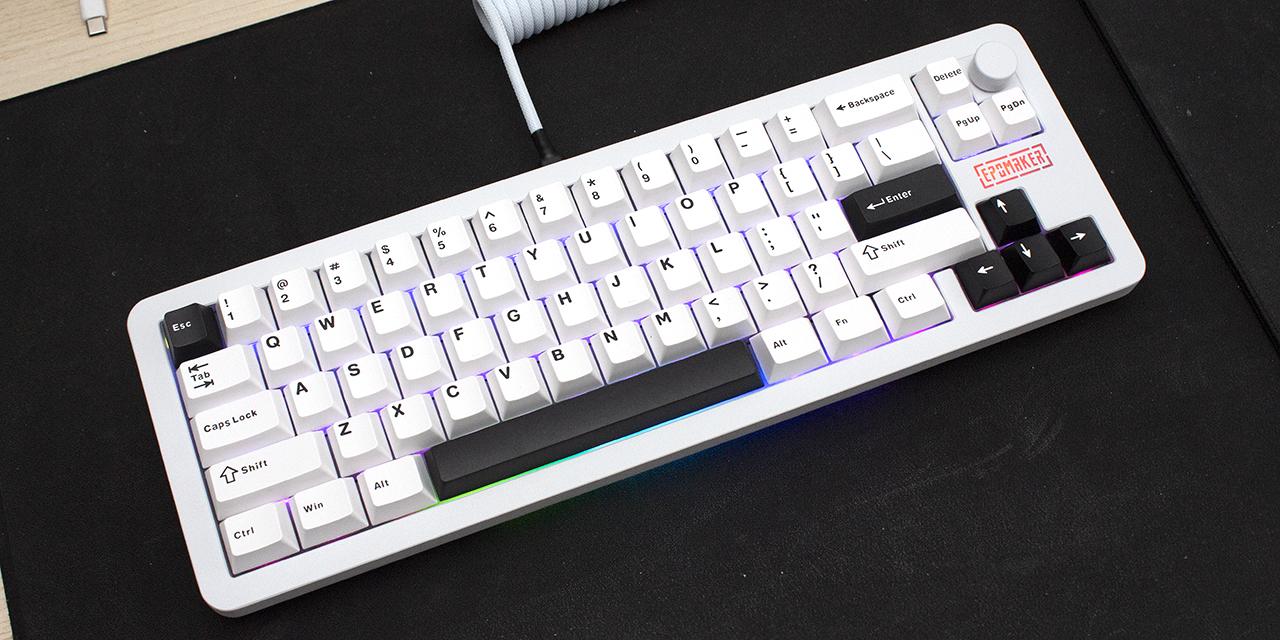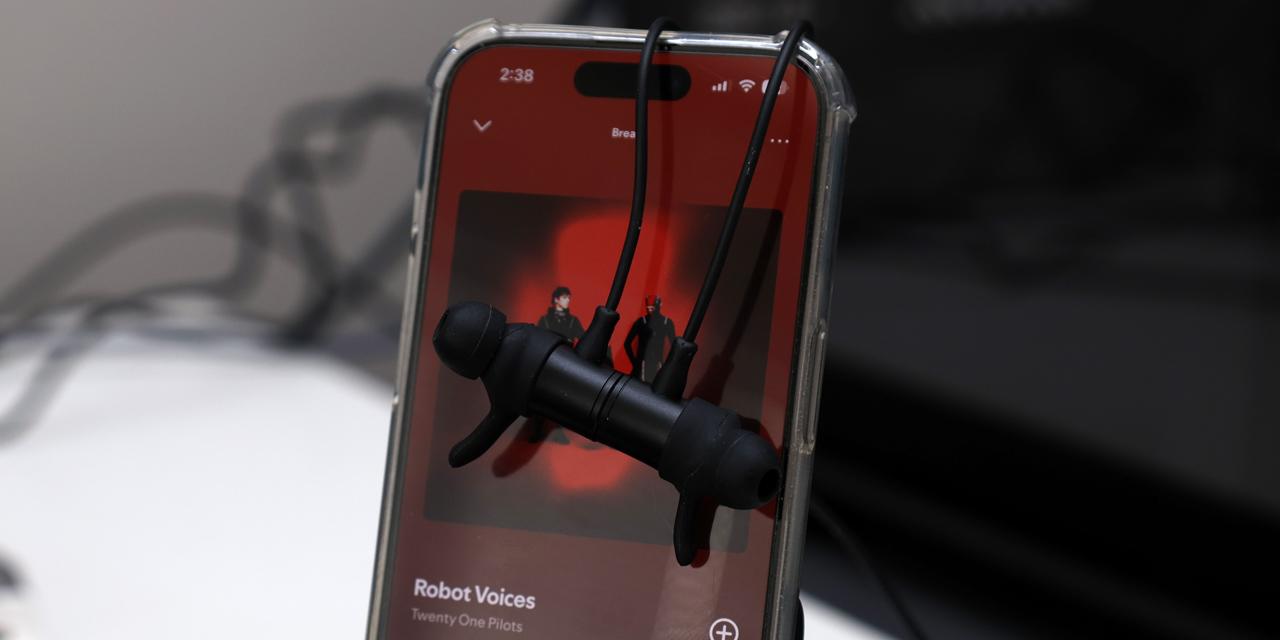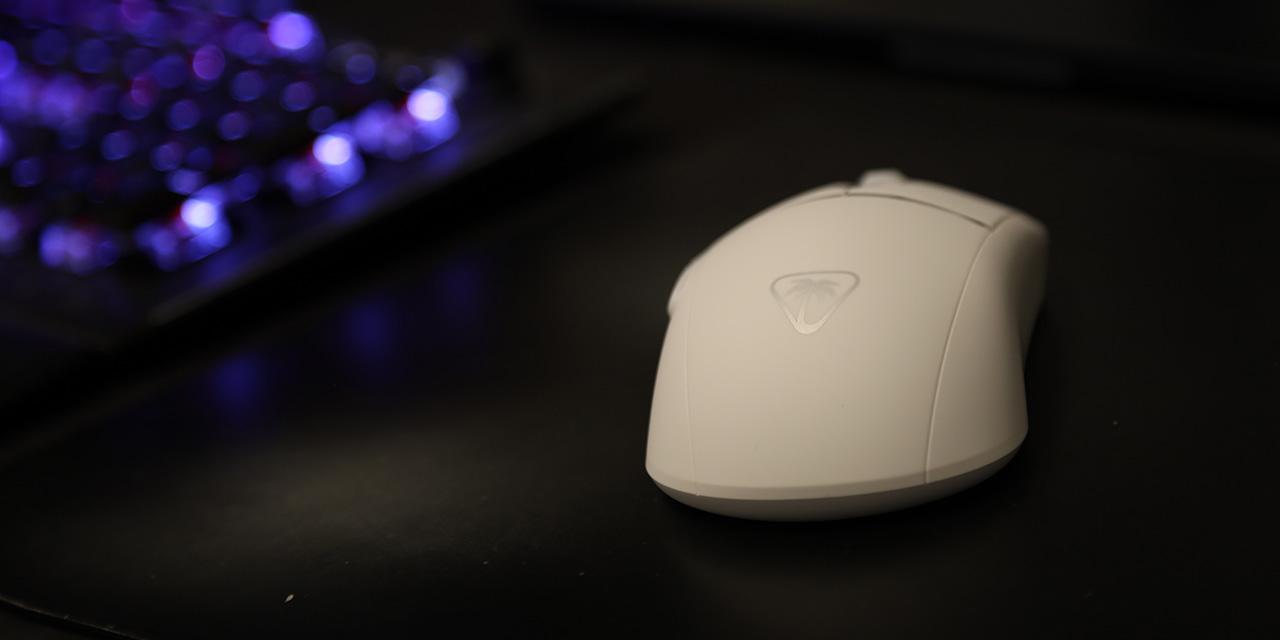Page 2 - A Closer Look - Hardware and Software

If you think you have seen this keyboard before, I will not blame you, as the Epomaker HE80 looks like the Epomaker Magcore 87. This includes the almost all-black exterior with white legends on each keycap. We also have the same purple translucent keycaps on Escape, Backspace, Enter, and space bar. These keycaps are easy to see through, so users can get a better view of the switch and stabilizers under the applicable keys. However, the HE80 is unique with its more curved plastic frame and a smoother finish. This makes the whole keyboard easier to hold by its sides. There is also a small translucent area near the arrow key cluster, which is situated over a cluster of RGB LED lights, as we will see later. Overall, it is a conservative looking design and color palette, which means it should fit on any desk.
In terms of dimensions, the Epomaker HE80 is 332mm wide, 146mm deep, and 40mm in height. It is average size for a 75% size. The keyboard is sturdy, even with its plastic frame. It weighs 830g, which is average for its size. As for build quality, there is a bit of give and flex in the enclosure, and a slight amount of deck flex. This is not too surprising given its gasket-mounted FR4 plate. The front edge of the frame is approximately 22mm tall, which means you can add a palm rest here, but one is not included.

The keys on the Epomaker HE80 are a standard North American QWERTY ANSI layout. The one alteration is the additional key on the top function row for a total of eighty-two keys. This results in the rest of the F1 to F12 keys being slightly more squished together. This additional key is for Insert. The layout is easy to grow accustomed to, as nearly all the keys are where you would expect. The primary difference with the 75% layout is the right side. This results in no number pad and a reduced set of the six cluster that usually is over the arrow keys. Instead, we have five of the six keys in a column on the right side. The bottom row has a slightly altered layout. On the left side of the space bar, there are standard 1.25U keys, but the right side is smaller with only three 1U keys for Alt, Fn, and Ctrl. The right Shift key is also smaller than usual to fit the arrow cluster. Unfortunately, we do not have a volume knob anywhere, which is something I like.

There are secondary functions on the Epomaker HE80, but they are not printed on the keycaps. Instead, you can look at the user manual. To access these functions, start by pressing the Fn key on the bottom right side before pressing the specified key. All the top function row keys have secondary functions. The first set are F1 to F5 to launch different system applications, including This PC, system browser, Calculator, Mail, and multimedia player. F6 to F9 are media functions for Stop, Previous track, Play/Pause, and Next track. Finally, F10 to F12 are used for Mute, Volume Down, and Volume Up.
Function and Windows key let you lock or unlock this key, which is handy for gaming. Finally, there are shortcuts for the keys that are missing with this layout. The secondary functions for Home, I, O, and P keys are End, Print Screen, Scroll Lock, and Pause Break, respectively. Epomaker also supports Mac functions, and they are placed where you might expect on a Mac keyboard. You can switch modes by pressing Fn + A for Windows and Fn + S for Mac. If you make any changes you want to reset, you can hold down Fn + Escape for five seconds, which will revert to factory settings. There are secondary keys for lighting controls, but we will explore these later in the review.

The bottom of the Epomaker HE80 is clean and smooth. There is no label in the middle, and instead the information is printed directly on the bottom area. This includes the product name and a small descriptor, along with certifications and a Made in China label. The corners have rubber pads to keep the keyboard in place. There are also a pair of different height kickstands. As such, there are three different incline angles of the HE80, including 6, 8.5 and 11.5 degrees. The kickstands have rubber padding on them to prevent movement when it is propped up. There is a screw in each corner to hold the top and bottom shells together. The only other thing of interest is located on the back edge, which is the USB Type-C port for connecting the keyboard to your computer. This is only wired, so there are no wireless-related items here.

On the table, the Epomaker HE80 blends in over a gray XTracGear Carbonic XXL. Even so, I really like the look of see-through keycaps. Otherwise, the curved edges look nice and feel better on the hands compared to a sharp corner. In terms of layout, everything is where I expect it to be. I do like tenkeyless keyboards more, but I also prefer this over any full-sized option.
As for the typing experience, the Epomaker HE80 is decent to type on. As you know, we have Hall effect switches underneath. These are a bit different from typical mechanical switches, and the overall typing feel shows this. This makes the switches feel a lot more sensitive out of the box, but this can be modified in software. Keystroke travel is smooth without any scratchy feel or squeaking sound. Overall, the sound is a bit more clacky and not as deep on each press. When you bottom out the switch, it feels sturdy without a spongy base or feel. On the other hand, longer keys like the space bar and Enter feel quite hollow and sound different. Overall, the typing experience may not be thocky or like crunching on rocks, but I found it enjoyable.

As we have seen from many double-shot PBT keycaps, the lighting solution on the Epomaker HE80 is more like an under glow than shine through. However, this has a few tricks up its sleeve. For one, the see-through keycaps let light shine straight through, making for a very visible light. Also, the backplate under the keys are white, which spreads the lighting better. Even still, in the dark, you will not see your keys. The south-facing lights shine around the keycap and are a bit more visible to the user. There is also a light diffuser above the right arrow key, although this has its own pattern. At maximum brightness, the lighting is still nice to see, even if it does not show up in the photo.
Lighting controls can be adjusted via secondary functions on the Epomaker HE80. Once again, you need to press Fn first before the specific key. To change the effect, you can press '\', while toggling the color is done with ']'. Changing the light effect's direction can be done with '['. Page Up and Page Down are used to toggle the small light diffuser's effects and colors, respectively. The Up and Down arrows increase and decrease the backlighting brightness. The Left and Right arrow keys decrease and increase the speed of the effects. Finally, you can disable the lighting with Fn + Backspace. You can also change these settings in the software.

Instead of an application on your computer, the Epomaker HE80 can be configured through a webpage, which requires permission to alter your connected peripherals. This only works with Chromium-based browsers, such as Google Chrome or Microsoft Edge. The overall user experience is acceptable, but my primary complaint comes in the scaling of the graphics and user interface elements or text.
As for details, the menus are located on the left side menu. The Custom Keys is where you can reassign what each key does. This includes regular, lighting, media, and macros. Next, the Lighting Settings are used to change all the lighting effects, including static, dynamic, and reactive options. Under Macro Manager, users can create and save their own series of actions. In Performance, users can change the travel distance on a per key basis. By default, these are set to 1.2mm, but they can be changed in the range of 0.1mm to 3.3mm in 0.02mm increments. Here, you can also set up fast trigger mode to change how quickly you need to release and press again for each key. This sensitivity can be in the range of 0.02mm to 3.3mm. This means at this travel distance, you will not need to fully release and re-press the fast triggered keys.

The second-to-last menu is called Advanced Keys, where you can make even more settings that are specific to the Hall effect switches. There are five different options to choose from. First, we have RS or Rappy Snappy, which checks two keys and activates the one that is pressed further down. Next, we have SOCD, which monitors two keys and activates the one based on a given rule set that you can set. Usually, this rule is just based on which was last pressed. Third is DKS, or Dynamic Keystroke, to bind a single button to up to four functions based on pressing or releasing at four distinct positions. MT is used to change functions based on either holding or single tapping a key. Finally, TGL turns on continuous triggering when you hold down a key. Epomaker warns users of these functions may be banned from certain FPS games if they have these active, so use them at your own peril. Even so, it is nice to see these functions that take advantage of the analog nature of the keys.
Finally, the Settings opens on a new page where you can change the interface theme and language, change the polling rate, update the firmware, and factory reset the unit. Overall, I think this HE80 driver webpage is usable, but there is a lot of empty spacing on the page that makes it look too empty. I wish Epomaker would better scale these graphical elements, especially on larger screens, to take advantage of the real estate. Otherwise, I did not notice any bugs while using the driver, which is good to see.
Page Index
1. Introduction, Packaging, Specifications
2. A Closer Look - Hardware and Software
3. A Closer Look - Disassembly and Internals
4. Conclusion

